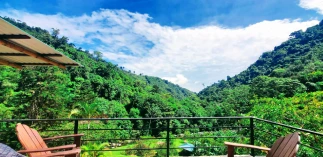Here at our secluded Costa Rican retreat, nestled amidst the emerald embrace of the mountains, we share our haven with a dazzling array of avian wonders. Today, we turn our gaze to a creature that might just surprise you with its diminutive stature – the Tiny Hawk.
True to its name, the Tiny Hawk (Microspizias superciliosus) is a miniature marvel. Often mistaken for a robin at first glance, this pint-sized predator stands at a mere 9-10 inches tall, making it one of the smallest accipiters in the world. But don’t let its size fool you. The Tiny Hawk packs a punch in the form of sharp talons and a fierce hunting spirit.
Habitat and Habits:
While sightings can be a delightful surprise, the Tiny Hawk prefers the dense cloak of the rainforest. Look for them in the humid lowlands and foothills of the Caribbean slope, and the Pacific slopes from around Carara National Park down to the Golfo Dulce area. They frequent the forest canopy and subcanopy, occasionally venturing to the edges or clearings for a spot of sunbathing on exposed branches.
Spotting a Tiny Hawk:
These little raptors are notoriously shy and masters of camouflage. However, with a keen eye and a bit of patience, you might be lucky enough to catch a glimpse. Here are some tell-tale signs to watch for:
- Size and Shape: As mentioned earlier, their size is a giveaway. Look for a bird smaller than a robin with a relatively short tail.
- Coloration: Adult males are a sight to behold with their dark, ashy gray upperparts and a lighter gray head capped with a black crown. Their underparts are a crisp white with fine gray bands. Females, on the other hand, are generally browner with buffy underparts marked by brown barring. Juveniles stand out with their warmer rufous plumage.
- Behavior: Tiny Hawks are solitary hunters, rarely seen in pairs. Keep an eye out for them perched on branches, their sharp gaze scanning for prey.
A Fearsome Appetite:
Despite their tiny stature, Tiny Hawks are formidable predators. Their diet consists primarily of small birds, including the dazzling hummingbirds that flit through the Costa Rican rainforests. Their hunting style involves perching strategically and launching surprise attacks on unsuspecting prey.
A Treasure of the Rainforest:
The Tiny Hawk is a vital part of the Costa Rican rainforest ecosystem. By preying on smaller birds, they help maintain a healthy balance in the food chain. Even though spotting them can be a challenge, the thrill of encountering this little marvel amidst the lush greenery is an unforgettable experience.
Tips for Birdwatching:
If you’re eager to see a Tiny Hawk on your Costa Rican adventure, here are some things to keep in mind:
- Join a guided birding tour: Our experienced guides know the best birding spots and have a keen eye for spotting elusive birds.
- Early mornings and late afternoons: These times offer the best chance of seeing birds active and feeding.
- Patience and Persistence: Birdwatching is about enjoying the sights and sounds of the rainforest. Be patient and keep your eyes peeled!
By following these tips and venturing into the verdant heart of Costa Rica, you might just be rewarded with a glimpse of the mighty mite – the Tiny Hawk.
For more information, please view our comprehensive guide about the birds of Costa Rica







